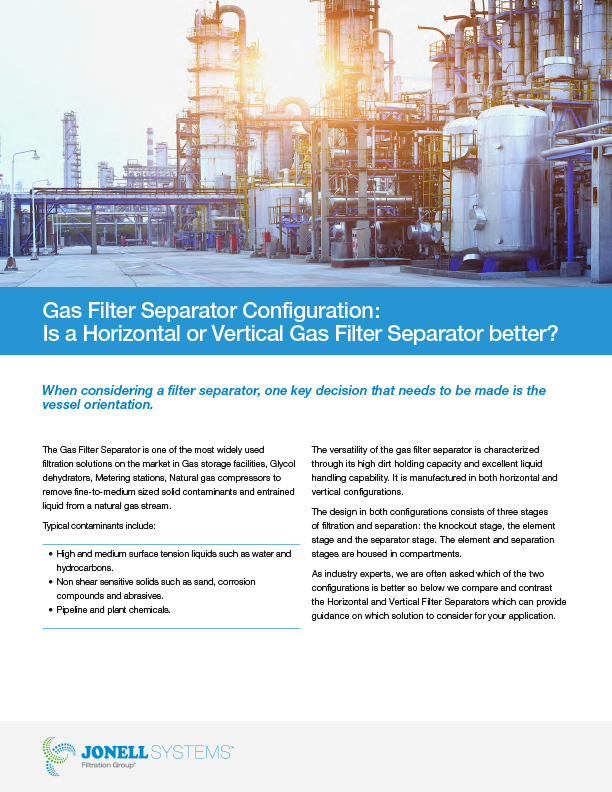Gas Filter Separator Configuration
Gas Filter Separator Configuration:
Is a Horizontal or Vertical Gas Filter Separator better?
WHEN CONSIDERING A FILTER SEPARATOR, ONE KEY DECISION THAT NEEDS TO BE MADE IS THE VESSEL CONFIGURATION OR ORIENTATION.
Gas storage facilities, Glycol dehydrators, Metering stations, Natural gas compressors to remove fine-to-medium sized solid contaminants and entrained liquid from a natural gas stream. Typical contaminants include:
- High and medium surface tension liquids such as water and hydrocarbons.
- Non shear sensitive solids such as sand, corrosion compounds and abrasives.
- Pipeline and plant chemicals.
The versatility of the gas filter separator is characterized through its high dirt holding capacity and excellent liquid handling capability. It is manufactured in both horizontal and vertical configurations.
The design in both configurations consists of three stages of filtration and separation: the knockout stage, the element stage and the separator stage. The element and separation stages are housed in compartments.
As industry experts, we are often asked which of the two configurations is better so below we compare and contrast the Horizontal and Vertical Filter Separators which can provide guidance on which solution to consider for your application.
| CRITERIA | HORIZONTAL FILTER SEPARATOR | VERTICAL FILTER SEPARATOR | ADVANTAGE |
| Vessel Footprint | Horizontal orientation requires full footprint which is larger than Vertical Filter Separator. | Vertical orientation has a 20-40% smaller footprint than the Horizontal Filter Separator. | Vertical |
| Bulk Liquids Handling | High liquid loads are handled at the primary knockout section and can directly enter the primary sump allowing the Horizontal Filter Separator to cope with upset conditions much better. | Liquids impact on the baffle and are split between dropout and element section making the knockout section less effective at removing bulk liquids than the horizontal orientation. | Horizontal |
| Element Changeout | Horizontal Changeout is typically easier on operators and safer with less or no bending and reaching. | Vertical Changeout requires operators to bend/reach and can require boards to be placed over the closure to reach center elements in large vessels making change-outs more difficult. | Horizontal |
| Vessel Diameter | Inlet is on risers without a baffle which means smallest possible vessel diameter. | Baffled inlet requires larger vessel to fit in the equivalent number of cartridges | Horizontal |
| Separator Sizing | Because of the bulk removal between the ESP and the separator, the separator does not see full liquid load to second section and the larger water droplets are removed before they reach the separator. The gap between the knockout & separator stage allows us to size for higher contaminant load for the same size vessel. | All liquids to the second section are introduced at the top of the separator so the Separator sees 100% of the liquids, with 100% drainage distance required. The direction of flow of gas & flow of water removal are both the same flowing down through the vessel. The vessel may need to be up sized for high liquid loading leading to a larger vessel for same removal efficiency compared to horizontal filter separator. | Horizontal |
| Liquid Storage (Primary) | Sump can be designed independent of the vessel to upsize/ size as needed to account for higher liquid loading. Shielded liquid section makes level controls more reliable and vessel cleanout is more easily accomplished with flanges on sumps. | In a vertical vessel, sump upsizing means upsizing the whole vessel which has a cost impact. Slugging directly impacts the liquid levels making controls during upsets more difficult. | Horizontal |
| Liquid Storage (Secondary) | Second stage can be the same size as first or designed separately as per application requirements or cost targets. | Vessel shell can be lengthened, or diameter increased to increase the storage impacting the size of the whole vessel. | Horizontal |
| Vessel Ancillary Structures | Platforms generally not required for small vessels while they may be needed for larger vessels. | Full height platform required on almost all units for changeouts and maintenance to access the opening. | Horizontal |
| Overall Fabrications and Material Costs | Separate sump section and saddles increase fabrication cost however the overall vessel maybe smaller for the same efficiency compared to a vertical vessel. | Vessel diameter will always be larger and Separator section will be more expensive however support skirt will be less expensive than saddles and separate sumps are not needed. | Vertical |
While the contaminants, application and process details determine the final solution recommendation, Vertical Filter Separators are a good option to consider when there are space limitations and vessel footprint is a limiting factor. Vertical Filter separators may also be more economical to purchase.
When the feed is variable, Horizontal Filter Separators have an advantage because of superior liquid loading. They are also easier and more economical to maintain.
We have a full range of gas filtration solutions including horizontal and vertical gas coalescers, horizontal and vertical gas filter separators and dry gas filters so get in touch with Jonell Systems to discuss your gas filtration application.

